This post has not been edited by the GamesBeat staff. Opinions by GamesBeat community writers do not necessarily reflect those of the staff.
![]()
Full disclosure: Q-Games sent me a free PlayStation Network download code for this article.
If we can call it a game, developer Q-Games' new music title PixelJunk 4am is the weirdest one I've played in a while. It has no goals or points, and it's impossible to fail in the traditional sense. It's a real-time audio mixer featuring music by Japanese multimedia artist Baiyon in which you use the PlayStation Move controller to manipulate different tracks, samples, and one-off sound effects in any way you want.
4am is actually two programs: the mixer I just described and a live virtual lounge where you can just sit and watch other people's live "performances." The person making the music can see how many people are in the crowd, and the audience can award "kudos" when they like what the player is doing. It's a little difficult to explain without seeing it in action, and I went through several distinct emotional stages before I could decide whether 4am was genuinely fun or just an especially shiny visualizer.
Here's what happened to me.
Stage 1 – Apprehension

The first thing I noticed when I started up 4am was that the ball on my PlayStation Move controller was lit up bright green. "Oh, shit," I realized, "…it's a damn glow stick."
It's cool if you like glow sticks, but one time in college, I walked by the dorm room of a guy who was having what I described to my friends later as a "one-man rave." It was one of the saddest things I've ever seen, and I hoped that I wasn't about to participate in one.
Stage 2 – Fascination

Once I got into the game's tutorial, it started throwing around terms like "virtual audio canvas." 4am's interface is that the music lives in corners of an imaginary square that is, like, all around you, man. When you want to pull in a track, you reach up your Move controller until you feel it vibrate and then hold down the trigger button while you pull it into the music space. You use the face buttons (X, Circle, Triangle, Square) to swap between different kinds of tracks (e.g., rhythm and synth lines), and if you wave your hand around while holding the Move button, you can add effects to the tracks that are playing. It sounds complicated, and it is.
Stage 3 – Apprehension 2: The Cringening

After I went through a few of 4am's tutorials, I reached a point at which I realized that I could not keep track of all of the instructions it was throwing at me. Hold this button, double-tap that button, this color means drums…it was exhausting. Luckily, the game spaces out the tutorials and lets you play around in between them to let you get the hang of things before you move on.
Stage 4 – Performance Anxiety

The biggest obstacle I encountered in the game was knowing that people were going to be watching me play, live. They wouldn't be able to see me (luckily), and I wouldn't know who they were, but I'd know how many of them were out there, silently judging me over the PlayStation Network, and the number of kudos I received would give me some idea of how they thought I was doing (which in turn would inform how I thought I was doing).
I don't really like playing games in front of other people unless they're also playing. I think it's because when I watch people play something, I'm constantly thinking about how much differently I would do everything, and of course I project that exceptional rudeness onto everyone else in the world.
Stage 5 – Acceptance

Once you're actually playing PixelJunk 4am, everything just clicks. Or maybe it doesn't, but it did for me. The interface is intuitive, and even if you aren't sure what you're doing at any given moment, everything you do does something. The coolest part is that the real-time visualizer gives you something to focus on (or fall into, if you're prone to trances), and it provides valuable feedback for the changes you're making.
After a very tentative start, I began experimenting with effects, dropping in loops, and adding and removing tracks. I got into it. My audience grew, and the kudos started coming in. I was making music, insofar as a person waving around a glowing ball can be said to be making anything but a fool of himself. I was also dancing a little, but luckily nobody could see that.
Having said all that, I'm not really sure what the long-term value of PixelJunk 4am is. It costs $9.99 (the Live Viewer is free), and its value really depends on what you put into it and how much its core concept excites you. It is still one of the most unique game experiences I've ever had, though, and anyone who is serious about music should check it out.
